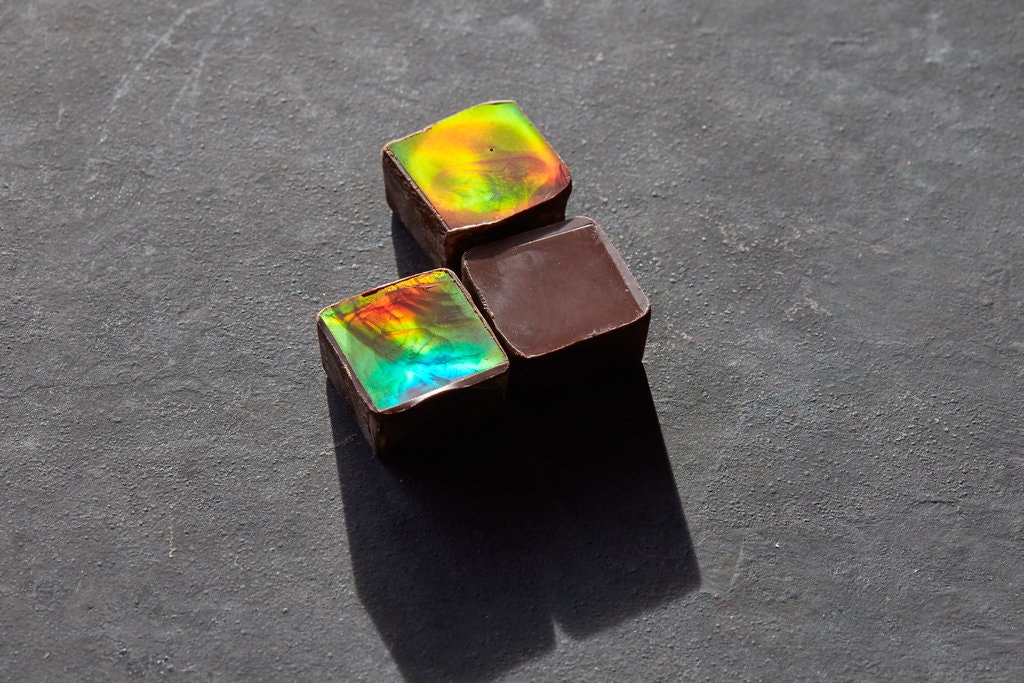Would you like chocolate that shimmers like a rainbow?
By Devi Lockwood
Earlier this month, Samy Kamkar shared his latest creation on Twitter: chocolate that shimmers like a rainbow.
Mr. Kamkar is not a chocolatier. He’s a founder of the internet security company Openpath, and gained early internet notoriety in 2005 for releasing a virus on the Myspace social network. He also has a 3-D printer and a penchant for experimenting with his food.
A few years ago, he had seen a similar iridescent effect on black plastic at a maker meet-up in Los Angeles — this object provided the first taste of inspiration.
“I wondered what else I could do this on,” he said.
A Swiss research team’s iridescent chocolate. Video by ETH Zurich / Giulia Marthaler
Mr. Kamkar first considered making the iridescent effect on hard candy, but then decided that would be too easy. Chocolate, with its melty gooeyness, seemed like a bigger challenge. After two months of playing around, Mr. Kamkar created a repeatable technique.
“Anyone can do this at home,” he said. “There’s no coating. There’s no special ingredient. It’s the surface texture of the chocolate itself that’s producing it.”
I’m finally getting some decent results producing 100%-edible iridescent tempered chocolate. The colors are from the chocolate (not any ingredient or coating) diffracting light after being forcefully molded onto a diffraction grating in vacuum.
He designed a 3-D model for casting that included, at its base, a saw-tooth wave pattern. Each of the grooves is a few micrometers wide. The chocolate, when poured inside, adapted the inverse of this pattern on its surface.
To prepare the chocolate for this mold, Mr. Kamkar tempered it — melting and cooling the chocolate in a calibrated sequence, with each step allowing certain crystalline structures to form and give the chocolate its optimum properties.
Next, Mr. Kamkar pressurized the chocolate in a vacuum chamber to prevent air bubbles from forming, though he says this step might not be necessary. He chose to create a mushroom-shaped mold because “mushrooms are magical.”
I’m finally getting some decent results producing 100%-edible iridescent tempered chocolate. The colors are from the chocolate (not any ingredient or coating) diffracting light after being forcefully molded onto a diffraction grating in vacuum. pic.twitter.com/6wpbsIKh5C
— Samy Kamkar (@samykamkar) May 9, 2020
The principle behind this chocolaty magic is diffraction — when light interacts with a surface and is drawn or pulled apart. It’s similar to refraction, which occurs when white light is broken into a rainbow through a prism.
On an object with many uniform lines and edges, like Mr. Kamkar’s cast chocolate, diffracted light becomes the dominant light that you see, creating iridescence. This same process — parallel reflective grooves in spacing comparable to the wavelength of light — creates rainbows on the surface of a compact disc. Dr. Weitz noted that many insects and butterflies use a similar phenomenon of closely spaced, parallel lines to show off iridescent wings or bodies.
“It’s the best tasting diffraction grating you’ll ever see,” said David A. Weitz, a professor of physics and applied physics at Harvard, of the chocolate. “It’s a simple idea. And to me, when I say something is simple, it is the best compliment I’ll pay.”

No additives needed, it’s just physics.Credit…Giulia Marthaler/ETH Zurich
Dr. Weitz, who studies structural color and teaches a class on science and cooking, added that the saw-tooth pattern Mr. Kamkar used isn’t all that important. As long as the lines are uniform, parallel and spaced in proximity to the wavelength of light, any pattern will do, from straight lines to curves.
“The basic fundamental physics will be the same,” he said.
Mr. Kamkar is not the only person who has had this idea. Swiss researchers have been collaborating to create marketable iridescent chocolate for two and a half years. Using the same technique as Mr. Kamkar, they can produce small batches of iridescent chocolates. The scientists’ next goal is to start a company, make more of the chocolate and sell it.
Their main obstacle right now is market acceptance. Although the chocolate contains no additives, many consumers find it hard to believe. “Maybe the surface is actually too shiny,” said Patrick Rühs a food scientist who became involved in the research with a group of colleagues while studying at the Swiss university ETH Zurich. “People think that there is a plastic foil on top, which is not the case.”
For Mr. Kamkar, business is not a priority. He is working on a how-to video to share with people who want to make iridescent chocolate at home. For him, the process of creating and playing in the kitchen is “just super fun.”
_______________________________
Credit: The New York Times


















